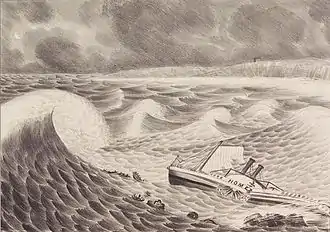SS Home
SS Home was a steam packet ship built in 1836 and wrecked in 1837. She was commanded by Captain Carleton White.
 Awful wreck of the Steam Packet Home: on her passage from New York to Charleston, Nathaniel Currier's hand-colored lithograph showing the wreck in October 1837 during the Racer's hurricane. | |
| History | |
|---|---|
| Name: | SS Home |
| Owner: | Red Bank line, New York City |
| Operator: | Carleton White |
| Builder: | Allaire Works, New York City |
| Launched: | 1836 |
| Fate: | Wrecked off Cape Hatteras, 9 October 1837 |
| Notes: | 130 on board |
| General characteristics | |
| Tonnage: | 537 |
| Length: | 220 ft (67 m) |
| Beam: | 22 ft 6 in (6.9 m) |
| Propulsion: |
|
| Notes: | 90 lives lost |
History
Home was built for Mr. James B. Allaire, of New York City, a paddle steamer of 537 tons, 220 feet (67 m) long and with a beam of 22 feet (6.7 m), propelled by two sidewheels mounted amidships. Like other ships of her day, Home had masts, sails, and rigging as well.
Home was built for river trade, but was converted into a passenger ship. Her interior was paneled in deep mahogany and cherrywood with skylights, saloons, and luxurious passenger quarters. A total of US$115,000 was spent converting Home for ocean voyages, but she was equipped with only three lifeboats and two life preservers. She was insured for only US$35,000.
Loss
On Saturday, 7 October 1837, Home left New York City for Charleston, South Carolina, with about 90 passengers and 40 crew aboard. Home had made only two previous voyages to Charleston. Home struck a sandbar off New Jersey. Unaware of the extent of the damage, her captain proceeded on schedule for Charleston. She encountered the 1837 Racer's Storm and started taking on water as she rounded Cape Hatteras, North Carolina. She was put aground to ride out the developing storm. Before rescue operations could be effected the next day, the Home was torn to pieces by the surf and 90 lives were lost.
Notable passengers lost in the disaster
- The Hardy Croom family of Tallahassee, Florida. Hardy Croom established one of Tallahassee's premier cotton plantations called Goodwood Plantation.
- Oliver H. Prince and wife Mary Prince. Oliver was on the Board of Trustees of the University of Georgia and had been a United States Senator from Georgia as well as Georgia State Senator.
References
- Hurricanes from the Handbook of Texas Online
- biography of the SS Home's owner, James Peter Allaire
- North Carolina Hurricane History
- Flagpole Magazine, p. 10 (6 September 2000).
- Contemporary Newspaper accounts of the loss of the "Home" 1837-1843
External links
 Media related to Home (ship, 1836) at Wikimedia Commons
Media related to Home (ship, 1836) at Wikimedia Commons